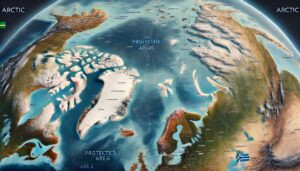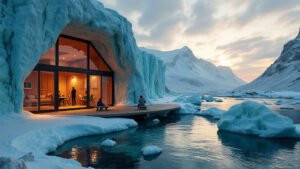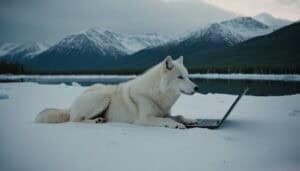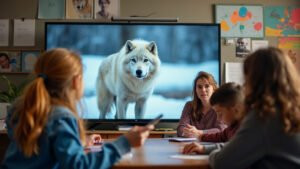Introduction
Learning about Arctic wolves can be an exciting and educational experience for students. This article explores a variety of hands-on activities that can be used in the classroom to help students gain a deeper understanding of these fascinating creatures
From building habitat models to engaging in virtual reality experiences, these activities are designed to provide practical and immersive learning opportunities. Additionally, students will learn about Arctic wolf behavior, footprint analysis, and the impact of climate change on their environment
Through these activities, educators can create a dynamic and interactive learning environment that fosters curiosity and a love for wildlife
Building a Model of an Arctic Wolf Habitat
Creating a model of an Arctic wolf habitat is a hands-on activity that provides students with a tangible understanding of the environment in which these animals live. This activity not only enhances their knowledge of Arctic wolves but also encourages teamwork, creativity, and problem-solving skills
Materials Needed
To build an Arctic wolf habitat model, students will need a variety of materials that can either be purchased or gathered from around the classroom
Essential items include:
- A large base, such as a cardboard box or foam board
- Modeling clay or papier-mâché for creating terrain
- Paints and brushes for detailing the landscape
- Small plastic trees and plants to represent Arctic flora
- Figurines of Arctic wolves and other wildlife
- Cotton balls or synthetic snow for creating snow effects
- Glue, scissors, and other basic craft supplies
Gathering these materials in advance ensures that students can focus on the creative aspects of the project without interruptions
Step-by-Step Guide
Planning the Habitat
Begin with a discussion about the Arctic tundra, focusing on the key elements that make up the habitat of Arctic wolves, such as snow-covered landscapes, sparse vegetation, and other wildlife
Have students sketch their ideas for the habitat, deciding where to place mountains, trees, and the wolves themselves
Creating the Base
Use the cardboard box or foam board as the foundation of the habitat
Build up the terrain using modeling clay or papier-mâché, forming hills, valleys, and other landscape features
Painting and Detailing
Once the terrain is set and dried, students can paint the landscape to resemble the Arctic tundra, using white for snow, green for moss, and gray or brown for rocks
Add small plastic trees and plants to represent the limited flora found in the Arctic region
Adding Wildlife
Place figurines of Arctic wolves in their appropriate settings within the habitat. Discuss where they might find food, shelter, and raise their pups
Include other animals that share the habitat, such as hares, foxes, and birds, to create a complete ecosystem
Final Touches
Use cotton balls or synthetic snow to add realistic snow effects on the ground and trees
Review the model as a class, discussing any additional details that could enhance the habitat’s realism
Educational Benefits
Building a model of an Arctic wolf habitat offers several educational benefits:
Enhanced Understanding: Students gain a concrete understanding of the physical environment and the challenges Arctic wolves face, such as extreme weather and limited food sources
Teamwork and Collaboration: This group activity fosters teamwork as students must work together to plan, create, and finalize their habitat model
Creative Thinking: Students use their creativity to design and build the habitat, which helps develop problem-solving and critical thinking skills
Interdisciplinary Learning: This activity integrates science (biology and ecology), art (design and modeling), and geography (understanding the Arctic region), providing a well-rounded educational experience
By engaging in this hands-on project, students not only learn about Arctic wolves but also develop a deeper appreciation for the complexity and beauty of their natural habitat
Understanding Arctic Wolf Behavior
Understanding the behavior of Arctic wolves is crucial for students to appreciate how these animals survive and thrive in their harsh environment. This section provides various hands-on activities to help students learn about Arctic wolf behavior through observation, role-playing, and research projects
Observation Activities
Video Analysis
Materials Needed: Access to nature documentaries or online videos featuring Arctic wolves
Activity: Have students watch selected videos, focusing on specific behaviors such as hunting, pack dynamics, communication, and raising pups
Discussion: After viewing, discuss as a class what behaviors were observed and what they might indicate about the wolves’ social structure and survival strategies
Field Journals
Materials Needed: Notebooks, pens, and videos or live stream footage of Arctic wolves
Activity: Students keep a field journal where they record their observations of Arctic wolf behavior. Encourage them to note the time of day, weather conditions, and any interactions between wolves
Reflection: Have students share their findings with the class and discuss patterns or unusual behaviors.
Role-Playing Exercises
Pack Dynamics Simulation
Materials Needed: Large open space, role cards with different wolf roles (alpha, beta, omega, pups)
Activity: Assign students different roles within a wolf pack and have them act out daily activities such as hunting, protecting territory, and caring for young
Debrief: Discuss the importance of each role within the pack and how it contributes to the survival of the group
Hunting Strategies
Materials Needed: Role cards, objects to represent prey, and a large space
Activity: Divide students into small groups representing wolf packs. Each pack must strategize and ‘hunt’ the prey using different tactics observed from their studies
Evaluation: After the activity, evaluate the effectiveness of each strategy and discuss what worked well and what didn’t
Case Studies and Research Projects
Case Studies
Materials Needed: Access to research articles, case studies on Arctic wolves
Activity: Assign students different case studies about Arctic wolf packs, such as how they adapt to seasonal changes or the impact of human activities on their behavior
Presentation: Have students present their case studies to the class, highlighting key findings and implications for Arctic wolf conservation
Research Projects
Materials Needed: Internet access, library resources, research templates
Activity: Students choose a specific aspect of Arctic wolf behavior to research in-depth, such as communication methods or pack hierarchy
Report: Each student writes a research report and shares their findings through a poster presentation or digital slideshow
Educational Benefits
Understanding Arctic wolf behavior through hands-on activities provides numerous educational advantages:
Deepened Knowledge: Students gain insights into the daily lives and survival strategies of Arctic wolves, enriching their overall understanding of animal behavior
Critical Thinking: Analyzing videos, role-playing, and conducting research projects develop students’ critical thinking and analytical skills
Empathy and Conservation Awareness: By learning about the challenges Arctic wolves face, students develop empathy for these animals and an awareness of the importance of conservation efforts
Engagement and Interaction: These interactive activities keep students engaged and make learning about Arctic wolves more dynamic and memorable
Through these activities, students will not only learn about Arctic wolf behavior but also appreciate the complexity and adaptability of these fascinating animals
Analyzing Arctic Wolf Footprints
Analyzing Arctic wolf footprints is a practical activity that helps students understand more about these animals’ movement patterns, behavior, and interactions with their environment. This section provides detailed guidance on how to conduct footprint analysis through collecting data, identifying characteristics, and drawing conclusions
Collecting Footprint Data
Field Trip Simulation
Materials Needed: Sand or clay, Arctic wolf footprint molds, measuring tape, notepads, and pens
Activity: Set up a simulation area where students can ‘discover’ and record wolf footprints in a controlled environment
Recording: Students measure the size and depth of the footprints, note the direction they are heading, and sketch the prints
Digital Resources
Materials Needed: Access to online databases or apps that provide images and data on Arctic wolf footprints
Activity: Have students use these digital resources to study and compare different sets of footprint data, noting variations and similarities
Discussion: Discuss the advantages and limitations of using digital resources versus real-life fieldwork
Identifying Characteristics
Footprint Analysis Worksheet
Materials Needed: Worksheets with diagrams of different animal footprints, including Arctic wolves
Activity: Students use the worksheet to identify key characteristics of Arctic wolf footprints, such as size, shape, and claw marks
Comparison: Have students compare Arctic wolf prints to those of other similar-sized animals, like domestic dogs or coyotes, to understand distinguishing features
Interactive Labs
Materials Needed: Access to interactive lab software or kits that allow students to study and analyze footprints in detail
Activity: Students use the lab resources to examine the anatomical features of wolf paws and how these relate to their footprints
Reflection: Encourage students to reflect on how the structure of a wolf’s paw aids in their movement and hunting capabilities
Drawing Conclusions
Hypothesis Formation
Materials Needed: Data collected from footprint analysis activities, charts, and graphing tools
Activity: Students form hypotheses about Arctic wolf behavior based on their footprint data, such as estimating the speed and direction of movement or identifying hunting patterns
Testing: Discuss how they could test these hypotheses through further observation or additional data collection
Research Reports
Materials Needed: Internet access, library resources, templates for scientific reports
Activity: Students write research reports summarizing their findings from footprint analysis, including their hypotheses, methods, results, and conclusions
Presentation: Have students present their reports to the class, highlighting key insights and any questions that arose during their research
Educational Benefits
Analyzing Arctic wolf footprints offers several educational benefits:
Hands-On Learning: Students engage in practical, hands-on activities that bring theoretical knowledge to life
Scientific Inquiry: This activity promotes scientific inquiry and critical thinking as students form and test hypotheses based on real data
Attention to Detail: Analyzing footprints requires careful observation and attention to detail, skills that are valuable across many disciplines
Understanding Wildlife: Students gain a deeper understanding of how wildlife scientists study animals in their natural habitats and the importance of such research for conservation efforts
By analyzing Arctic wolf footprints, students not only learn about the physical characteristics and movement patterns of these animals but also develop important scientific skills and an appreciation for wildlife research
Virtual Reality Experiences of the Arctic Tundra
Virtual reality (VR) technology provides an immersive and engaging way for students to learn about the Arctic tundra and the lives of Arctic wolves. This section outlines how to incorporate VR experiences into the classroom, covering available programs, setup instructions, and integration into the curriculum
Available VR Programs
Google Expeditions
Features: Google Expeditions offers a range of VR tours, including those focusing on Arctic environments and wildlife
Activity: Students can embark on a guided VR tour of the Arctic tundra, observing Arctic wolves in their natural habitat
Benefits: This program is user-friendly and provides comprehensive educational content, making it an excellent resource for classroom use
National Geographic VR
Features: National Geographic VR provides high-quality, immersive experiences of various natural environments, including the Arctic
Activity: Students explore the Arctic landscape, learning about the flora, fauna, and the specific adaptations of Arctic wolves
Benefits: The program’s rich visual and auditory elements enhance students’ understanding and engagement
Arctic Wolf VR Simulation
Features: This specialized VR program focuses specifically on the life and behavior of Arctic wolves
Activity: Students can simulate the experience of being an Arctic wolf, making decisions about hunting, pack dynamics, and survival
Benefits: This interactive simulation helps students understand the challenges Arctic wolves face and the strategies they use to survive
Setting Up the Experience
Equipment Requirements
Materials Needed: VR headsets, compatible smartphones or computers, access to the selected VR programs
Preparation: Ensure all equipment is charged and the VR programs are downloaded and tested prior to the lesson
Classroom Setup
Space Arrangement: Arrange the classroom to allow enough space for students to move safely while using VR headsets
Safety Briefing: Provide a safety briefing on how to use the VR equipment properly and what to do in case of discomfort
Guided Exploration
Introduction: Start with an introduction to the Arctic tundra and the specific focus of the VR experience
Immersion: Guide students through the VR experience, pausing at key points to discuss observations and answer questions
Debrief: After the VR session, hold a debriefing discussion where students can share their experiences and insights
Integrating VR into the Curriculum
Lesson Planning
Objective Alignment: Ensure the VR experience aligns with the learning objectives of the lesson or unit
Pre- and Post-Activities: Plan activities before and after the VR experience to enhance learning. Pre-activities might include reading assignments or discussions about the Arctic environment, while post-activities could involve reflective essays or group projects
Cross-Disciplinary Connections
Science Integration: Use the VR experience to teach concepts related to biology, ecology, and environmental science, such as adaptation, food chains, and climate change
Art and Writing: Encourage students to create art projects or write stories based on their VR experiences, fostering creativity and reinforcing their understanding of the Arctic tundra
Assessment and Reflection
Quizzes and Tests: Develop quizzes or tests to assess students’ knowledge gained from the VR experience
Reflective Journals: Have students keep reflective journals where they record their thoughts and insights from the VR sessions
Educational Benefits
Using virtual reality to explore the Arctic tundra and the lives of Arctic wolves offers several educational advantages:
Immersive Learning: VR provides an immersive experience that makes learning more engaging and memorable
Enhanced Understanding: Students gain a deeper understanding of the Arctic environment and the behavior of Arctic wolves through realistic simulations
Accessibility: VR experiences make it possible to explore remote and challenging environments that students might not otherwise be able to visit
Interactivity: Interactive elements of VR programs encourage active learning and participation, helping students retain information more effectively
By incorporating VR into the curriculum, educators can provide students with a unique and impactful way to learn about the Arctic tundra and Arctic wolves, fostering a greater appreciation for these fascinating animals and their environment
Simulating Arctic Wolf Tracking
Simulating Arctic wolf tracking is an engaging hands-on activity that teaches students about the techniques and tools used by wildlife biologists. This section explains how to create a tracking scenario, utilize tools and techniques, and analyze the tracking results
Tools and Techniques
GPS Devices
Materials Needed: Handheld GPS devices or GPS apps on smartphones
Activity: Teach students how to use GPS devices to track the movement of Arctic wolves. Explain how biologists use these tools to monitor the wolves’ locations and movements in real time
Practice: Have students practice by marking waypoints and tracking a pre-determined route within the school grounds
Radio Collars
Materials Needed: Mock radio collars and receivers
Activity: Demonstrate how radio collars are used to track wildlife. Have students simulate placing a collar on a wolf and then using a receiver to track its location
Discussion: Discuss the ethical considerations and challenges of using radio collars in wildlife research
Trail Cameras
Materials Needed: Trail cameras or motion-activated cameras
Activity: Set up trail cameras around the school to capture images of ‘wildlife’ (e.g., students acting as wolves)
Analysis: Review the captured images and discuss how biologists use trail cameras to study animal behavior and population density
Creating a Tracking Scenario
Designing the Scenario
Materials Needed: Map of the school or local park, markers, role cards
Activity: Design a tracking scenario where students take on the roles of biologists and Arctic wolves. The ‘wolves’ move around the area, leaving clues (e.g., footprints, fur, scat), while the ‘biologists’ use their tracking tools to follow them
Preparation: Mark key locations on the map where clues will be left, and prepare role cards with specific behaviors for the ‘wolves’ to enact
Conducting the Simulation
Instructions: Divide students into groups, with some acting as wolves and others as biologists
Tracking: The biologists use their tools to track the wolves, recording data such as locations, movement patterns, and any clues found
Observation: Ensure that students accurately simulate behaviors and use the tracking tools correctly
Analyzing Tracking Results
Data Compilation
Materials Needed: Data sheets, maps, graphing tools
Activity: Have students compile their tracking data, creating maps that show the movement patterns of the Arctic wolves
Graphing: Students can graph the distances traveled, speed, and frequency of certain behaviors observed during the tracking simulation
Hypothesis Testing
Materials Needed: Data from the tracking simulation, hypothesis templates
Activity: Students form hypotheses about Arctic wolf behavior based on their tracking data, such as preferred routes or resting spots
Evaluation: Discuss how biologists test similar hypotheses in the field and compare the students’ findings with known Arctic wolf behavior
Reporting Findings
Materials Needed: Report templates, presentation tools
Activity: Each group prepares a report summarizing their tracking data, hypotheses, and conclusions. They should include maps, graphs, and any notable observations
Presentation: Have students present their findings to the class, discussing any challenges they faced and what they learned about Arctic wolf tracking
Educational Benefits
Simulating Arctic wolf tracking offers several educational benefits:
Practical Application: Students apply theoretical knowledge in a practical setting, deepening their understanding of wildlife biology
Critical Thinking: Tracking simulations require students to think critically and problem-solve, skills that are essential in scientific research
Teamwork: This activity fosters teamwork and collaboration as students must work together to track the wolves and analyze data
Real-World Skills: Students gain experience using tools and techniques that biologists use in the field, providing insight into the day-to-day work of wildlife researchers
Engagement: The hands-on nature of this activity keeps students engaged and motivated, making learning about Arctic wolves more enjoyable and impactful
By simulating Arctic wolf tracking, students not only learn about the behavior and ecology of these animals but also gain valuable skills and experiences that can inspire future interest in wildlife conservation and research
Conclusion
Engaging students in hands-on activities to learn about Arctic wolves offers a dynamic and immersive educational experience. Building a model of an Arctic wolf habitat allows students to creatively explore the physical environment and challenges faced by these animals
Understanding Arctic wolf behavior through observation, role-playing, and research projects deepens students’ knowledge and empathy for these creatures. Analyzing Arctic wolf footprints provides practical insights into their movement and habits, fostering critical thinking and scientific inquiry. Virtual reality experiences offer an immersive way to explore the Arctic tundra, making learning more engaging and memorable
Finally, simulating Arctic wolf tracking teaches valuable skills and techniques used by wildlife biologists, providing a real-world application of theoretical knowledge. Through these diverse activities, students not only gain a comprehensive understanding of Arctic wolves but also develop a passion for wildlife conservation and scientific exploration










